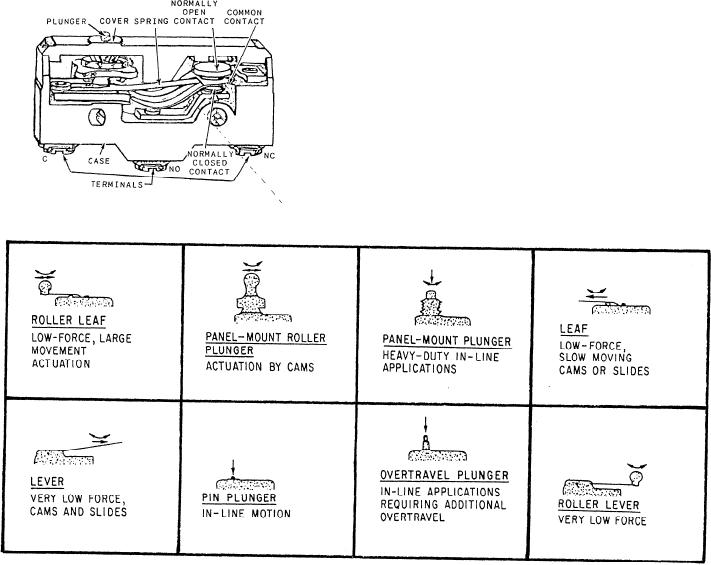
MICROSWITCH DESIGN AND OPERA-
lamp operation. There are so many types of control
TION. The frill description of the microswitch shown
circuits installed in naval ships that it is impractical to
list any definite operating test procedures. In general,
in figure 5-5 is a two-position, single-pole,
control circuits are best tested by using the circuits as
double-throw, single-break, momentary-contact,
they are intended to be operated. When testing control
precision, snap-acting switch. Notice the terminals
circuits, always use standard safety precautions to guard
marked C, NO, and NC. These letters stand for common,
against damage to associated equipment.
normally open, and normally closed. The common
terminal is connected to the normally closed terminal
Control circuits send commands (signals) that
until the plunger is depressed. When the plunger is
operate valves, pumps, fans, and other electrical and
depressed, the spring will "snap" into the momentary
electronic circuits. One important device used in control
position. The common terminal is now connected to the
circuits is the precision snap-acting switch.
normally open terminal. As soon as the plunger is
released, the spring will "snap" back to the original
Maintaining Precision Snap-Acting Switches
position.
A precision snap-acting switch is a switch in which
This basic microswitch is used in many applications
the operating point is preset and very accurately known.
as an automatic switch. Several different methods are used
The operating point is the point at which the plunger
to operate this type of switch. Some of the more common
causes the switch to "switch." This switch is commonly
actuators and their uses are shown in figure 5-6.
known to the GSEs as a microswitch. An example of a
MICROSWITCH MAINTENANCE. Micro-
microswitch is shown in figure 5-5.
switches are usually very reliable electrical components.
T h i s means they do not fa i l ve r y of t e n . Most
micros witches are designed to operate more than
100,000 times without failing if the voltage and current
ratings are not exceeded. Even so, microswitches do fail.
There are two basic methods used to check a
Earlier in your career, you learned to remove power
from the circuit and isolate the component being
checked. The best way to isolate a microswitch is to
remove it completely from the circuit. This is not always
practical, however, and sometimes you must check a
Figure 5-5.--Microswitch.
microswitch while power is applied to it. In those cases,
Figure 5-6.--Common microswitch actuators.
5-7

